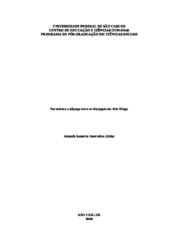| dc.contributor.author | Guerreiro Júnior, Antonio Roberto | |
| dc.date.accessioned | 2016-06-02T19:25:25Z | |
| dc.date.available | 2008-05-30 | |
| dc.date.available | 2016-06-02T19:25:25Z | |
| dc.date.issued | 2008-03-04 | |
| dc.identifier.citation | GUERREIRO JÚNIOR, Antonio Roberto. Parentesco e aliança entre os Kalapalo do Alto Xingu. 2008. 219 f. Dissertação (Mestrado em Ciências Humanas) - Universidade Federal de São Carlos, São Carlos, 2008. | por |
| dc.identifier.uri | https://repositorio.ufscar.br/handle/ufscar/1471 | |
| dc.description.abstract | The main aim of this paper is to describe and analyze the marriage alliance system of
the Kalapalo, a karib-speaking group from Alto Xingu (MT), by means of a critical review of
the available hypothesis on the xinguan kinship and the presentation of newer ethnographical
data on alliance in relation to the presently available ones in the anthropological literature
about the region. Such data allow to identify the types of existing unions and its respective
statistical trends, subsidizing the test of the current hypotheses on the forms of transmission
and production of affinity in upper-xinguan systems in the ethnographical context of the
kalapalo system. Still, one becomes able to question about the real reach and also the limits of
the hypothesis on the alliance structure of the peoples of the region to be of the
(patri)multibilateral type, therefore the data disclose the existence of an ideal and a strong
trend among the Kalapalo for the matrilateral marriage. Considering that the matrilateral
exchange is not a common fact in indigenous Amazonia, where variations of the patrilateral
marriage prevail, this characteristic of the kalapalo system leads us to question the
multibilateral model considered for the upper-xinguan systems, and becomes a basic problem
to investigate how these different structures combine in one same system. For that, a
diachronical analysis of some alliance nets will be made, considering the conditions of
production and redoubling of unions as well as the coexistence of two exchange structures
(one patri and another matrilateral), what will lead to a definition of the kalapalo system as
"complex" and to the association of the matrilateral marriages with the institution of
chieftaincy. | eng |
| dc.description.sponsorship | Financiadora de Estudos e Projetos | |
| dc.format | application/pdf | por |
| dc.language | por | por |
| dc.publisher | Universidade Federal de São Carlos | por |
| dc.rights | Acesso Aberto | por |
| dc.subject | Etnologia | por |
| dc.subject | Parentesco e casamento | por |
| dc.subject | Alto Xingu - Brasil | por |
| dc.subject | Índios Kalapalo | por |
| dc.subject | Índios da América do Sul - Brasil | por |
| dc.title | Parentesco e aliança entre os Kalapalo do Alto Xingu | por |
| dc.type | Dissertação | por |
| dc.contributor.advisor1 | Cardoso, Marina Denise | |
| dc.contributor.advisor1Lattes | http://genos.cnpq.br:12010/dwlattes/owa/prc_imp_cv_int?f_cod=K4781692Z8 | por |
| dc.description.resumo | O objetivo principal desta dissertação de mestrado é descrever e analisar o sistema de
aliança matrimonial dos Kalapalo, um grupo de língua karib do Alto Xingu (MT), por meio
de uma revisão crítica das hipóteses disponíveis sobre o parentesco xinguano e da
apresentação de novos dados etnográficos sobre aliança em relação aos presentemente
disponíveis na literatura antropológica da região. Tais dados permitem identificar os tipos de
uniões existentes e suas respectivas tendências estatísticas, subsidiando o teste das atuais
hipóteses sobre as formas de transmissão e produção da afinidade nos sistemas alto-xinguanos
no contexto etnográfico do sistema kalapalo. Ainda, torna-se possível discutir tanto o real
alcance quanto os limites da hipótese sobre a estrutura de aliança dos povos da região ser do
tipo (patri)multibilateral, pois os dados revelam a existência de um ideal e uma forte tendência
dos Kalapalo para o casamento matrilateral. Considerando que a troca matrilateral é um fato
pouco comum na Amazônia indígena, onde prevalecem variações do casamento patrilateral,
esta característica do sistema kalapalo leva à problematização do modelo multibilateral
proposto para os sistemas alto-xinguanos, e torna-se um problema fundamental investigar
como estas diferentes estruturas se combinam em um mesmo sistema. Para tanto, será feita
uma análise diacrônica de algumas redes de aliança, tendo em vista as condições de produção
e redobramento de uniões e a coexistência de duas estruturas de troca (uma patri e outra
matrilateral), o que levará a uma definição do sistema kalapalo como complexo e à
associação dos casamentos matrilaterais com a instituição da chefia. | por |
| dc.publisher.country | BR | por |
| dc.publisher.initials | UFSCar | por |
| dc.publisher.program | Programa de Pós-Graduação em Ciências Sociais - PPGCSo | por |
| dc.subject.cnpq | CIENCIAS SOCIAIS APLICADAS | por |
| dc.contributor.authorlattes | http://lattes.cnpq.br/1494640146100817 | por |
